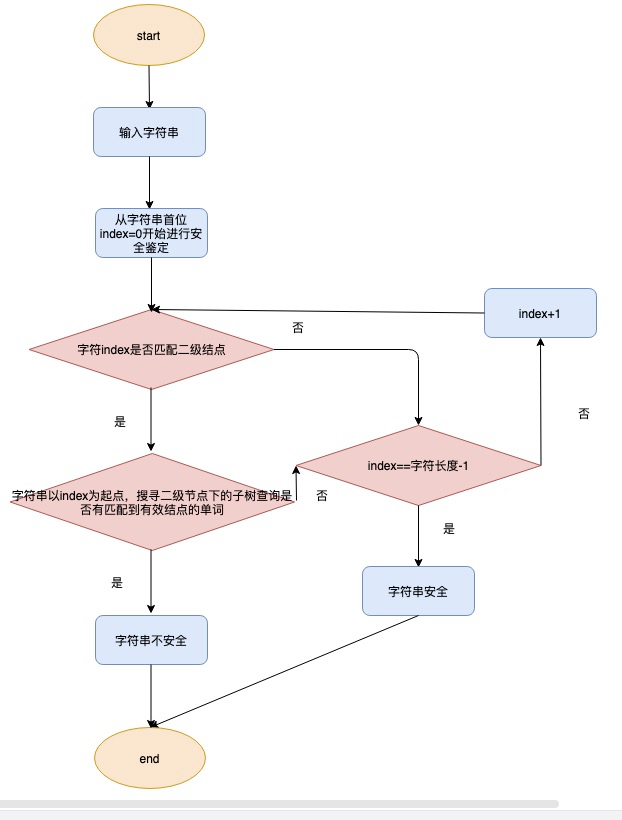一.前言
看了百度团队在 infoq 上发表的一篇【如何在秒级完成词表匹配】(https://xie.infoq.cn/article/97b2df7e41456335627ce4cd4)的文章,文章业务背景介绍的很清楚,里面有提到字典树,看到结构图我能明白工作原理,但是总感觉自己处于一种懂与不懂的半懂状态,希望通过写这篇文章我能彻底将字典树闹明白。
二.介绍
概念
字典树是一个存储字符串的树,一个节点的最大子节点数等于字母表的大小。支持在 O(L)时间内的搜索,插入和删除操作,L 是键的长度。
应用场景
1.可以在 O(L)时间内插入和查找字符串,其中 L 表示单个单词的长度。
2.可以轻松地按字母顺序打印所有单词。
3.可以使用字典树完成前缀搜索,这也是字典书叫前缀树的原因之一。
字典树样式
拥有字段:
(图有些问题,讲 i 视作右边最后一个节点)
b|bcd|abc|abd|abcd|efg|hi
总结
根据字典树特性,我们可以发现在敏感词场景中用字典树确实是一个很合理的选择,它采用空间换时间,保证用户可以在极短时间内获取字符串是否安全的结论,具体流程如下图所示:
针对百度的图,有以下两种情况
1.china,由于二级没有任何匹配的节点,所以安全
2.abd,在左边,有 abd 到有效节点 d,所以属于不安全
三.实现
了解了字典树的应用和特性,我们下一步要做的就是字典树的实现了,以下是我按照个人理解实现的源码,如有疑问欢迎沟通
3.1 字典树实现
type Trie struct { valid bool //判断是否是有效节点 value interface{} //节点的值 childMap map[interface{}]int //子节点下是否有这个节点的map记录 childNodes []*Trie //包含的所有节点}
func NewTrie() *Trie { t := &Trie{} return t}//新增数据时间复杂度是O(L),L是新增字符串的长度func (this *Trie) AddWord(word []byte) { if len(word) < 1 { return } length := len(word) if this.childNodes == nil { //不存在子级,需要重新创建 this.childNodes = append(this.childNodes, &Trie{ valid: length == 1, value: word[0], childNodes: nil, }) this.childMap = make(map[interface{}]int) this.childMap[word[0]] = 1 this.childNodes[0].AddWord(word[1:]) } else { index := this.childMap[word[0]] if index > 0 { //子级里面以及有这个值了 if len(word) == 1 && this.childNodes[index-1].valid == false { //已经存在这样的子级,且此值是有效值,当前节点无效,需要进行修改 this.childNodes[index-1].valid = true return } else { if length <= 1 { return } //已经存在这样的子级,且此值是有效值,当前节点也有效,则重复,进行下一步 this.childNodes[index-1].AddWord(word[1:]) } } else { //不存在这样的子级 this.childNodes = append(this.childNodes, &Trie{ valid: length == 1, value: word[0], childNodes: nil, }) this.childMap[word[0]] = len(this.childMap)+1 this.childNodes[len(this.childNodes)-1].AddWord(word[1:]) } }}//删除数据func (this *Trie) DelWord(word []byte) { //不存在则不删除 if !this.SearchNode(word){ return } length:=len(word) step:=1 prefix:=this index:=this.childMap[word[step-1]] node:=this.childNodes[index-1] for step!=length{ step++ index = node.childMap[word[step-1]] prefix = node node = node.childNodes[index-1] } //找到了最后一个word节点 if len(node.childNodes)!=0{ //word节点的后面还有值,只是这个节点不生效 node.valid = false }else{ //word节点后面没有值了,删除前面节点与后续节点所有关系,依靠golanggc进行回收 delindex := prefix.childMap[node.value] prefix.childMap[node.value] = 0 prefix.childNodes = append(prefix.childNodes[:delindex], prefix.childNodes[delindex+1:]...) }}
//按层分布func PrintTree(tries []*Trie) { if len(tries) <1{ return } //按照树打印,一次打印一个子树 var inertries []*Trie for i := 0; i < len(tries); i++ { fmt.Print(string(tries[i].value.(uint8))+" ") inertries = append(inertries,tries[i].childNodes...) } fmt.Print("\n") PrintTree(inertries)}
//查询,时间复杂度是O(L),L是查询字符串的长度func (this *Trie) SearchNode(word []byte) bool { if len(word) < 1 { return false } index := this.childMap[word[0]] if index == 0 { return false } else { if len(word)==1{ return this.childNodes[index-1].valid } return this.childNodes[index-1].SearchNode(word[1:]) }}
复制代码
3.2 测试代码
func main() { trie := NewTrie() trie.AddWord([]byte("abc")) trie.AddWord([]byte("abcd")) trie.AddWord([]byte("bcd")) trie.AddWord([]byte("efg")) trie.AddWord([]byte("hi")) trie.AddWord([]byte("b")) PrintTree(trie.childNodes) fmt.Println(trie.SearchNode([]byte("abcd"))) fmt.Println(trie.SearchNode([]byte("abc"))) fmt.Println(trie.SearchNode([]byte("b"))) fmt.Println(trie.SearchNode([]byte("hi"))) fmt.Println(trie.SearchNode([]byte("efg"))) fmt.Println(trie.SearchNode([]byte("china"))) fmt.Println(trie.SearchNode([]byte("ab"))) fmt.Println(trie.SearchNode([]byte(""))) trie.DelWord([]byte("ab"))//应该没有影响 fmt.Println("==================") fmt.Println(trie.SearchNode([]byte("abcd"))) fmt.Println(trie.SearchNode([]byte("abc"))) fmt.Println(trie.SearchNode([]byte("abcd"))) fmt.Println(trie.SearchNode([]byte("ab"))) trie.DelWord([]byte("abc"))//导致abc会找不到 fmt.Println("===================") fmt.Println(trie.SearchNode([]byte("abcd"))) fmt.Println(trie.SearchNode([]byte("abc"))) fmt.Println(trie.SearchNode([]byte("abcd"))) fmt.Println(trie.SearchNode([]byte("ab")))}
复制代码
参考文件
https://www.geeksforgeeks.org/advantages-trie-data-structure/
推荐阅读
|golang 解析 --- 进程,线程,协程
|golang学习之路--内存分配器















评论